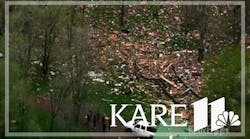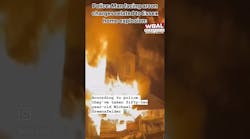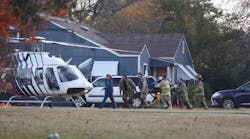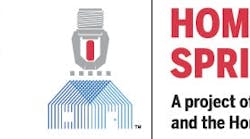On December 4, 2006, IAFC issued a "Member Alert" notifying their membership about the hazards associated with the lightweight construction in residential occupancies. In that member alert titled "Caution Urged with Composite Floors" it was stated:
"There have been several cases of firefighters falling through floors made of composite structural components and an even greater number of near-miss situations. This type of construction is being investigated as a contributing factor in a line-of-duty death.There is a proliferation of engineered floor systems in residential occupancies across the United States. Many newer residential occupancies incorporate lightweight, engineered wood or composite structural components, including trusses, wooden I-beams and lightweight flooring systems. In most cases, these systems are structurally sound and designed to support the appropriate loads under normal conditions; however, they are likely to fail very quickly under fire conditions.
These components and systems are most often found in situations where applicable codes do not require any rated fire resistance between floor levels. They have much less inherent fire resistance than conventional wood-joist floor systems and conventional wood decking. Remember - many codes do not require any fire resistance in residential floors! In the several cases of firefighters falling through floors, those floors had been exposed to fire from below for relatively short periods."
This indeed is great that the fire service organizations act so promptly to notify all of us about the urgency of recognizing such hazards. But, then what is the next step? Just adding this new problem to the very long list of many other hazards that we must be concerned about when responding to a fire is not the solution. Notification of such hazards is the first step. But, then I believe that we must take strong measures to modify our national building codes to address this concern.
These lightweight construction materials are extremely popular with the builders. Builders consider them to be "better performing, more durable, and environmentally friendly" as far as building homes. However, their performance under the adverse fire conditions is rather weak, and that is the gist of our deep concerns. Obviously the builders would not willingly discontinue constructing with these lightweight trusses, and this problem will not be going away any time soon. So, we might as well try to find a long-term win/win solution that not only protects the occupants, but also our own.
I believe that one such solution is installation of residential fire sprinkler systems in all new homes. Reports indicate that these lightweight structural members perform rather weak under the adverse fire conditions. That being the case, we should then use the fire sprinkler technology to put out the fires, before these structural members are even exposed to the fire. Wouldn't that make a great deal of sense, and a win/win solution? Let them build with their lightweight trusses, but then mandate them to install fire sprinkler in these buildings, so that the trusses don't fail under the adverse fire condition.
Obviously this solution will not have an impact on all the existing homes throughout the country. But, then it will have a long-term positive impact on the 1.5 million new homes constructed around the country every single year. And if we don't address this problem now, these new homes of today, will be where we will be fighting the fires of tomorrow, and where we will be collecting our future fire fatalities and loss statistics.
But how do we go about changing those building codes to require the residential fire sprinkler systems in all the new homes? Just like anything else in our democratic ways in America, change will only come about through mass participation in the established process. To see any change at all, the fire service must participate in full force and with all their might in the code development process.
There is no better way that I could describe the importance of participation, than this very inspiring and patriotic piece. This was part of a speech delivered by Mr. Walter Williams, who was one of the many distinguished speakers at the 1947 President's Conference on Fire Prevention. Mr. Williams stated:
"Sometimes I think we are inclined to think that, "Well, I as an individual cannot do very much." Let me give you just a grand example to show how wrong you can be in that belief. Three or four years ago, after the war had got well under way, the Boeing Aircraft Co. in Seattle was having a great deal of difficulty in recruiting employees to turn out its B-17's and B-29's, and so after having exhausted the orthodox methods of recruitment, it called upon the Army and the Seattle Chamber of Commerce to help solve the problem, and here is what they did.They called together a huge mass meeting at the stadium of the University of Washington. That stadium ordinarily would hold perhaps 45,000 people. On this particular occasion the outpouring of the public was so great that by loudspeaker each person was asked to crowd over so that three people could sit where two would normally sit, and so I suppose it is safe to say that there were 60,000 people gathered there that evening.
The Governor of the State was there, the mayor was there, we had other dignitaries there. Gen. Hap Arnold was there and gave a half-hour radio talk on a national hook-up. It was a great occasion. But perhaps you will understand why the outpouring when I tell you that Jerry Colona was there, and Frances Langford was there, and Bob Hope was there. Need I say more?
Yet in spite of the attractions and the grandness of that program, there was a young fellow who was wearing the khaki of Uncle Sam's Army who stole the show. Just about the middle of the program he stood out there in the open end of that horseshoe stadium, which had as its backdrop beautiful Lake Washington and the Cascade Mountains, and standing there in a simple, non-oratorical style he said, "I want to say a few words to you about the purchase of war bonds." Then he went on to say, "Perhaps you think that the purchase of a $25 bond does not amount to much. I want to see if I can prove that you are mistaken. I wish every one of you would take a match out of his pocket. I am going to wait just a few moments, then I am going to ask that those floodlights be turned out, then I am going to ask that each one of you light his match."
Suddenly the lights went out and there was the most dazzling spectacle that those people who were there that night ever saw in their lives. A solid, blazing mass of light in a horseshoe made up of 1 match plus 59,999 others!
Do you think he drove home his point? I'll say he did! Twenty five dollars multiplied by 60,000 is a pretty tidy little sum, so he drove home to every individual there the lesson and the fact that the individual and the activity on the part of each individual do count, and I ask each of you not to forget that as you leave the halls of this conference room and go back home."
I believe that this excerpt really drives the point home about the importance of each individual, and also the impact of mass participation. This indeed is a great example of the power of many ones.
I believe that each one of us as an individual, and all our professional organizations representing the fire service in our country must participate in changing the current national building codes, to mandate the requirement for installation of residential fire sprinkler systems in all new homes. Never, underestimate the power of many ones, and the importance of our participation. Together we can make it happen. Remember "FIRE SPRINKLERS SAVE FIREFIGHTERS' LIVES TOO".
Mr. Mirkhah is the Fire Protection Engineer (FPE) for the City of Las Vegas Department of Fire & Rescue. His responsibilities include reviewing all building fire and life safety system designs and submittals to insure compliance with the federal, state and local fire and life safety codes and standards. Mr. Mirkhah is also involved in the development of fire & life safety codes and standards for the city.
Mr. Mirkhah is a registered professional engineer with more than 25 years of work experience in the field of fire protection engineering. Mr. Mirkhah holds a Bachelor of Science degree in Mechanical Engineeri and is a graduate of the National Fire Academy's Executive Fire Officer Program.
Mr. Mirkhah is a member of the National Fire Protection Association (NFPA) and serves on the national NFPA 13 Technical Committee for Sprinkler System Discharge Design Criteria. Mr. Mirkhah is a member of the Society of Fire Protection Engineers (SFPE) and served on their Qualifications Board. You can contact Mr. Mirkhah at: [email protected].





